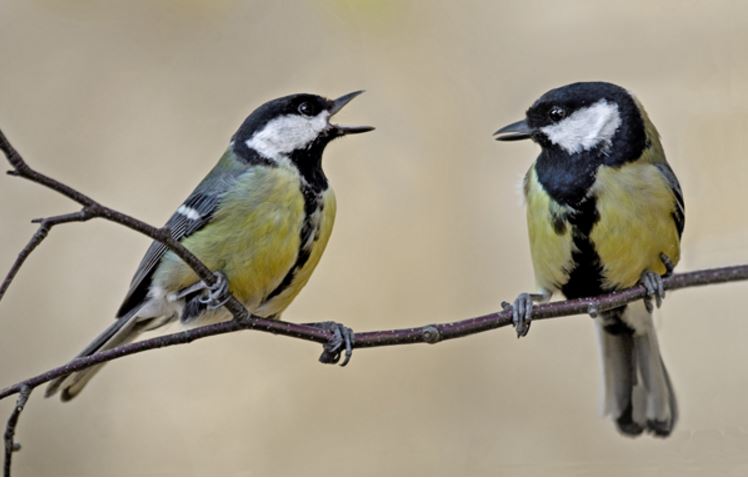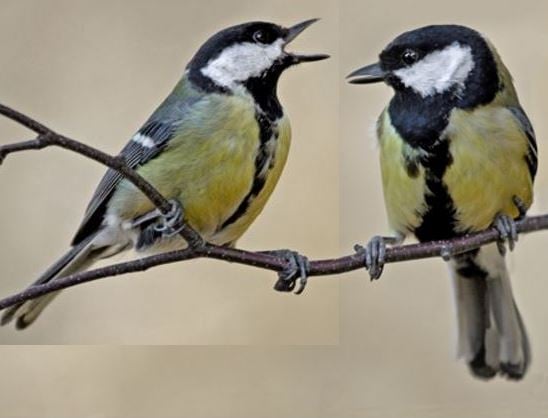Great tits in love have a bond that would be the envy of most human couples. They prefer to go without food rather than be separated from their mate, scientists from the University of Oxford reported in the journal Current Biology.
To understand what great tits are willing to do in human terms, imagine a couple standing outside a restaurant. Only one of them is allowed in. The one who is not allowed in chooses to wait by the door until his or her sweetheart has finished eating, rather than walk off to grab a sandwich nearby.
The researchers observed seventeen pairs of great tits in the Oxfordshire woods. They say that the birds stayed close to their mate all the time, not matter how hungry they were. Love mattered more than food for both the males and females, the authors wrote.
 Going hungry is a small price to pay for great tits in love. (Image: Wikimedia)
Going hungry is a small price to pay for great tits in love. (Image: Wikimedia)
Josh Firth, a DPhil student, and colleagues said their findings demonstrate just how important relationships are throughout the animal kingdom, including wild birds.
In this study, the seventeen pairs of birds all wore electronic anklets that emitted a signal that unlocked feeders laden with sunflower seeds.
The signals were set to either allow both the male and female into a feeder, or just one of the pair. So, the possible entries into the feeders included: 1. Both male and female. 2. Just the female. 3. Just the male.
Love conquers starvation … for the great tit
They studied the 34 birds for a period of three months and found that when only one was able to get into the feeder, the other would wait outside, as close as possible to his or her mate.
In fact, the birds that could not get into the feeder spent four times as long at the off-limit feeders than the other birds.
Put simply, as far as the great tit is concerned, love conquers all – the bird prefers to fly around with its mate, even if that means it gets nothing to eat. It will not choose to fly off separately in search of food while its better half feeds.
Mr. Firth explained:
“We were quite surprised to see that the pairs chose to stay together than go where they could get food themselves. They stuck with their partner and spent a lot more time at the feeder they couldn’t access.”
The locked out great tits found themselves spending a lot of time with their mate’s friends.
Mr. Firth commented:
“Because those birds choose to stay with their partners, they also end up associating with their partner’s flock-mates, even if they wouldn’t normally associated with this individuals.”
“This shows how the company an individual bird keeps may depend on their partner’s preferences as well as their own.”
Passing on one’s genes a top priority
By sticking close together, the birds were making sure their relationship remained solid, while at the same time ensuring that their genes were passed on.
This study just looked at the behaviours of great tits. However, the researchers believe that most wild bird species would do the same, especially those that form a bond for at least one breeding season.
Choosing hunger over separation did not appear to affect the birds’ health or body weight, the authors noted.
The locked-out bird soon noticed that when the feeding mate had had his or her fill and left, the lock did not shut for a few seconds, during which it swooped in and gobbled some sunflower seeds.
An an Abstract in the journal, the scientists concluded:
“Wild great tits shape their foraging activity around their mated partner and prioritize maintaining this relationship over their access to food. This key relationship also influenced their wider social associations by altering who else they foraged with, illustrating an important feedback between social structure itself and its suggested drivers.”
Citation: “Experimental Evidence that Social Relationships Determine Individual Foraging Behavior,” Josh A. Firth, Bernhard Voelkl, Damien R. Farine and Ben C. Sheldon. Current Biology. November 2015. DOI: http://dx.doi.org/10.1016/j.cub.2015.09.075.
RSPB Video – The great tit
The great tit Parus major, a woodland bird, is UK’s largest tit. It has a green and yellow body with a striking black head, white cheeks, and a distinctive two-syllable song. It has readily adapted to human habitats to become a familiar garden visitor.

